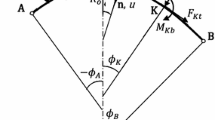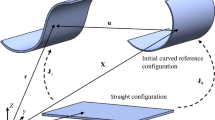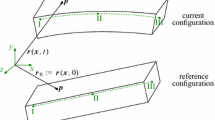Abstract
To develop an effective hybrid-mixed element, it is extremely critical as to how to assume the stress field. This research article demonstrates the effect of additional equilibrium stress functions to enhance the numerical performance of the locking-free three-node hybrid-mixed curved beam element, proposed in Saleeb and Chang’s previous work. It is exceedingly complicated or even infeasible to determine the stress functions to satisfy fully both the equilibrium conditions and suppression of kinematic deformation modes in the three-node hybrid-mixed formulation. Accordingly, the additional stress functions to satisfy partially or fully equilibrium conditions are incorporated in this study. Several numerical examples for static and dynamic problems confirm that the newly proposed element with these additional stress functions is highly effective regardless of the slenderness ratio and curvature of arches in static and dynamic analyses.
Similar content being viewed by others
References
A. K. Noor and J. M. Peters, Mixed models and reduced/selective integration displacement models for nonlinear analysis of curved beams, International Journal for Numerical Methods in Engineering, 17 (1981) 615–631.
H. Stolarski and T. Belytschko, Membrane locking and reduced integration for curved beams, Journal of Applied Mechanics, 49 (1982) 172–176.
G. Prathap and C. R. Babu 1986, An isoparametric 1uadratic thick curved beam element, International Journal for Numerical Methods in Engineering, 23 (1986) 1583–1600.
A. Tessler and L. Spiridigliozzi, Curved beam elements with penalty relaxation, International Journal for Numerical Methods in Engineering, 23 (1986) 2245–2262.
H. S. Ryu and H. C. Sin, Curved beam elements based on strain fields, Communications in Numerical Methods in Engineering, 12 (1986) 767–773.
P. Raveendranath, G. Singh and B. Pradhan Free vibration of arches using a curved beam element based on a coupled polynomial eisplacement field, Computers and Structures, 78 (2000) 583–590.
J. H. Lee, In-plane free vibration analysis of curved Timoshenko beams by the pseudospectral method, KSME International Journal, 17(8) (2003) 1156–1163.
A. Y. T. Leung and B. Zhu, Fourier p-elements for curved beam vibrations, Thin-Walled Structures, 42 (2004) 39–57.
C. B. Kim, J. W. Park, S. H. Kim and C. D. Cho, A finite thin circular beam element for in-plane vibration analysis of curved beams, Journal of Mechanical Science and Technology, 19 (2005) 2187–2196.
M. Gellert and M. E. Laursen, Formulation and convergence of a mixed finite element method applied to elastic arches of arbitrary geometry and loading, Computer Methods in Applied Mechanics and Engineering, 7 (1976) 285–302.
A. F. Saleeb and T. Y. Chang, On the hybridmixed formulation C 0 curved beam elements, Computer Methods in Applied Mechanics and Engineering, 60 (1987) 95–121.
Z. Zhang, A note on the hybrid-mixed C 0 curved beam elements, Computer Methods in Applied Mechanics and Engineering, 95 (1992) 243–252.
H. R. Dorfi and H. R. Busby An effective curved composite beam finite element based on the hybridmixed formulation, Computers and Structures, 53 (1994) 43–52.
J. G. Kim and Y. Y. Kim, A new higher-order hybrid-mixd curved beam element, International Journal for Numerical Methods in Engineering, 43 (1998) 925–940.
J. G. Kim and Y. K. Park, Hybrid-mixed curved beam elements with increased degrees of freedom for static and vibration analyses, International Journal for Numerical Methods in Engineering, 683 (2006) 6905–706.
H. Kraus, Thin Elastic Shells, Wiely, New York, USA, (1967).
T. Kaneko, On Timoshenko’s correction for shear in vibrating beams, Journal of Physics D: Applied Physics, 8 (1975) 1927–1936.?
G. R. Cowper, The shear coefficient in Timoshenko’s beam theory, Journal of Applied Mechanics, 33 (1966) 335–340.
T. H. H. Pian and D. P. Chen Alternative ways for formulation of hybrid-stress elements, International Journal of Solids and Structures, 18 (1982) 1679–1684.
G. R. Heppler, An element for studying the vibration of unrestrained curved Timoshenko beams, Journal of Sound and Vibration, 158 (1992) 387–404.
A. Krishnan and H. C. Suresh, A simple cubic linear element for static and free vibration analyses of curved beams, Computers and Structures, 68 (1998) 473–489.
Author information
Authors and Affiliations
Corresponding author
Additional information
This paper was recommended for publication in revised form by Associate Editor Maenghyo Cho
Jin-Gon Kim graduated from the Seoul National University in 1991, majoring in Mechanical Engineering. He received Master’s degree and Ph.D. degree in Mechanical Engineering at the Seoul National University in 1993 and 1998, respectively. He has worked for Samsung Electronics for three years from March 1998 to February 2001, and is currently in the School of Mechanical and Automotive Engineering at Catholic University of Daegu. Main research interests include structural/impact anlyses, advanced finite element method and CAE.
Yong Kuk Park graduated from the Seoul National University in 1987, majoring in Metallurgical Engineering. He received Master’s degree in Industrial and Systems Engineering at the University of Michigan in 1988, and Ph.D. degree in Manufacturing Engineering at the Ohio State University in 1995. He has worked for Samsung Motor Co., and is currently in the School of Mechanical and Automotive Engineering at Catholic University of Daegu, teaching Manufacturing Design, Statistical Quality Control, Casting and Plasticity, Forging and Press Forming, Advanced Studies in Plasticity. Main research interests include advanced mechanical design, manufacturing processes, design of manufacturing systems and statistical process control.
Rights and permissions
About this article
Cite this article
Kim, JG., Park, Y.K. The effect of additional equilibrium stress functions on the three-node hybrid-mixed curved beam element. J Mech Sci Technol 22, 2030–2037 (2008). https://doi.org/10.1007/s12206-008-0752-7
Received:
Revised:
Accepted:
Published:
Issue Date:
DOI: https://doi.org/10.1007/s12206-008-0752-7




